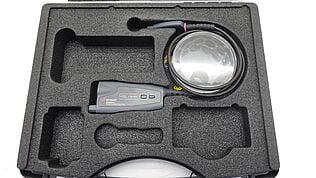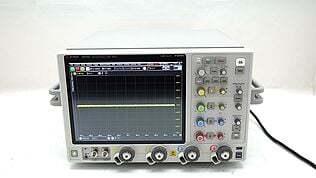- Introduction
- Different Types of Variable Attenuators
- Causes of Signal or Cable Attenuation
- Preventing of Improving Attenuation Rate
- Increasing Signal Strength to Prevent Attenuation
- Oscilloscope Attenuators
- Setting Attenuation on an Oscilloscope
- Attenuator Probes
- Key Terms To Remember:
- Popular Used Oscilloscopes
What is Attenuation? Meaning & Definition
Attenuation is the reduction in the amplitude of a signal as it travels through a medium. Attenuation can be caused by transmission loss, reflection, or absorption. In an electrical system, attenuation is a decrease in voltage as it flows along a wire or other transmission line. Attenuated systems can also be referred to as degraded systems.
Attenuation is expressed in decibels (dB) and represents the ratio of output to input power or intensity. Attenuation values can range from zero decibels for an unobstructed or perfect transmission, to extremely large negative numbers. A perfect attenuator with 0 dB of attenuation has an infinite number of taps along the transmission line.
Although the most accurate way to measure attenuation is through direct insertion of a calibrated attenuator into the system, an alternative method is to use test instruments that are capable of measuring voltage ratio or decibels. Attenuation can be measured with devices such as network analyzers, noise generators, and signal sources.
Buy Oscilloscopes at a Great Discount
Different Types of Variable Attenuators
- A resistive attenuator uses a network of fixed resistors to provide attenuation.
- A differential attenuator, also known as a transformer or "audio balun" is used in low-level audio applications where common-mode noise and interference are present.
- An RF (radio frequency) attenuator is a device that reduces power in an electrical signal and can also be used to control standing wave ratio (SWR).
- A coax attenuator is a device used to reduce signal strength. It is mostly applied in telecommunication systems, especially electromagnetic waves propagating through free space or along transmission lines.
- A passive attenuator is a signal processing electronic component that reduces signal level. The signal comes into the attenuator, is retained by the passive element of the device, and then exits at a reduced level. This signal transformation is opposed to amplification in which signal level increases.
Causes of Signal or Cable Attenuation
When we talk about signal or cable attenuation, we are talking about signal degradation between a transmitter and receiver.
Signal loss can be caused by many variables that affect cable quality, such as
- Poorly manufactured fiberoptics (bad connectors and poor splices)
- Excessive bending of the cable. This causes signal reflections which create "crosstalk" between strands.
- Operating at higher signal wavelengths.
- Long signal cable runs between transmitter and receiver (attenuation increases over signal cable length).
Preventing of Improving Attenuation Rate
There are several ways to prevent or improve attenuation. The most common ways are to:
- use a physical barrier between the two conductors, which prevents them from touching and shorting out.
- increase the power of a signal by using a preamplifier. A preamp boosts the strength of a signal before it reaches its destination, preventing signal loss from being as much of a concern.
- increase the distance between two conductors to prevent them from touching and shorting out by using a balun.
Increasing Signal Strength to Prevent Attenuation
There are several ways to increase signal strength.
You can:
- Place the antenna closer to the source.
- Improve conductivity by wiring together different materials.
- Make sure that there is nothing interfering with the signal.
- Place antennas far away from any metallic objects.
- Use a power amplifier for stronger signals if needed.
Oscilloscope Attenuators
An oscilloscope attenuator is a small circuit board installed between your oscilloscope and probes. This device has machined screw slots and gain settings that allow you to set it in order to reduce the amplitude of the signal you are viewing. Note that this does not reduce the power passing through your probes, it only reduces the amplitude of what is read by your oscilloscope.
Attenuation allows the user to reduce the amplitude of a signal captured by an oscilloscope probe without actually reducing the voltage or power passing through said probes. This is essential for observing signals all across the spectrum, especially when viewing high-power signals with fragile probes.
Setting Attenuation on an Oscilloscope
Attenuation on an oscilloscope is generally done using an RG-6 Coaxial Cable or a stereo cable. Both of these allow for easy adjustment, depending on the level required, which can be displayed in dB (decibels) or dBm (decibel-milliwatts).
Follow these simple steps to set attenuation on your oscilloscope:
- Set the oscilloscope to 10 divisions above your baseline (if your oscilloscope does not have a baseline, set your oscilloscope for 10 divisions between the vertical markers).
- Increase or decrease the amplitude of the signal to be attenuated.
- Determine how many divisions of attenuation are needed by dividing the measured voltage by the amplitude of the signal, and setting this number as the attenuation factor.
- Set your attenuator to that number or close to it (the closer you set your attenuator to the actual factor, the less change your displayed signal will show).
- If the attenuation factor is too great, you might need to set your attenuator one or two divisions lower than the number of divisions you are using for the number of divisions between vertical markers.
- Turn on your oscilloscope, and you are now ready to use an attenuated signal.
For more information about how to use an oscilloscope, check out our "Oscilloscope Basics" knowledge base article. You can also find a list of Keysight’s premium used Oscilloscopes here.
Attenuator Probes
An attenuator probe is an essential accessory for any oscilloscope. It contains a resistor to reduce the voltage of incoming signals, allowing them to be detected by the scope.
An attenuator probe is connected to the oscilloscope through BNC cables.
BNC cables are coaxial cables designed to be plugged into equipment with a 75-ohm impedance resistor (connectors are called T and/or C).
Attenuator probes are commonly used when:
- measuring high-voltage AC signals, which can damage low input impedance scopes if they are not attenuated down to safe voltages.
- the attenuating voltage of an electrical current that is higher than the oscilloscope can handle.
Visit Keysight Technologies to purchase attenuator probes for your oscilloscope.
Browse Oscilloscopes at a Great Discount
Select up to 3 instruments to compare
Enable Notifications
In order to use this feature, you need to enable notifications.
Manage notification preferences
Key Terms To Remember:
| Term | Definition |
|---|---|
| Attenuation | The reduction in the amplitude of a signal as it travels through a medium. |
| Balun | A device that converts between balanced and unbalanced circuits. |
| Preamplifier | An amplifier that is used at the input of a circuit to boost the strength of incoming signals where there might not be enough voltage for the load. |
| 10X attenuation | Voltage divided by 10. |

Subscribe to Get Our Latest News, Updates, and Articles.
Popular Used Oscilloscopes
Keysight Used Oscilloscopes offers a wide range of industry leading pre-owened oscilloscopes, ranging from older generation Agilent oscilloscopes to the newest Keysight oscilloscope models. So whether you are a fist time buyer, replacing a model like-for-like or looking for upgrade – we have something for you.















































